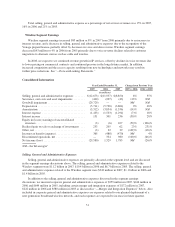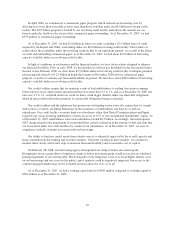Sprint - Nextel 2007 Annual Report Download - page 61
Download and view the complete annual report
Please find page 61 of the 2007 Sprint - Nextel annual report below. You can navigate through the pages in the report by either clicking on the pages listed below, or by using the keyword search tool below to find specific information within the annual report.Changes in certain assumptions could have a significant impact on the goodwill impairment charge. For
example, a decrease in OIBDA by 5% or an increase in capital expenditures by 5% would result in an additional
goodwill impairment charge equal to our remaining goodwill of $935 million. Conversely, an increase in OIBDA
by 5% or a decrease in capital expenditures by 5% would result in a reduction to the goodwill impairment charge
by $2.9 billion and $2.0 billion, respectively. A 50 basis point increase or decrease in the discount rate would
result in an approximate $350 million increase or decrease to the goodwill or impairment charge, respectively. A
50 basis point increase or decrease in the terminal growth rate would result in an approximate $400 million
decrease or increase to the charge, respectively. The sensitivity amounts above are calculated based on the impact
of the change in the fair value of the wireless reporting unit, as well as the impact of changes in the fair values of
the assets and liabilities of the wireless reporting unit.
The allocation of the fair value of the wireless reporting unit to individual assets and liabilities within the
wireless reporting unit also requires us to make significant estimates and assumptions. The allocation requires
several analyses to determine fair value of assets and liabilities including, among others, customer relationships,
FCC licenses, trademarks and current replacement costs for certain property, plant and equipment.
When required, we test other indefinite lived intangibles for impairment by comparing the asset’s respective
carrying value to estimates of fair value, determined using the direct value method. Our FCC licenses are
combined as a single unit of accounting following the unit of accounting guidance as prescribed by EITF Issue
No. 02-7, Unit of Accounting for Testing Impairment of Indefinite-Lived Intangible Assets, except for our FCC
licenses in the 2.5 GHz band, which are tested separately as a single unit of accounting.
The accounting estimates related to our indefinite lived intangible assets require us to make significant
assumptions about fair values. Our assumptions regarding fair values require significant judgment about
economic factors, industry factors and technology considerations, as well as our views regarding the prospects of
our business. Changes in these judgments may have a significant effect on the estimated fair values.
Tax Valuation Allowances and Uncertain Tax Positions
We are required to estimate the amount of taxes payable or refundable for the current year and the deferred
tax liabilities and assets for the future tax consequences of events that have been reflected in our consolidated
financial statements or tax returns for each taxing jurisdiction in which we operate. This process requires
management to make assessments regarding the timing and probability of the ultimate tax impact. We record
valuation allowances on deferred tax assets if we determine it is more likely than not that the asset will not be
realized. The accounting estimates related to the tax valuation allowance require us to make assumptions
regarding the timing of future events, including the probability of expected future taxable income and available
tax planning opportunities. These assumptions require significant judgment because actual performance has
fluctuated in the past and may do so in the future. The impact that changes in actual performance versus these
estimates could have on the realization of tax benefits as reported in our results of operations could be material.
We carried an income tax valuation allowance of $723 million as of December 31, 2007. This amount
includes a valuation allowance of $477 million for the total tax benefits related to net operating loss
carryforwards, subject to utilization restrictions, acquired in connection with certain acquisitions. The remainder
of the valuation allowance relates to capital loss, state net operating loss and tax credit carryforwards. Within our
total valuation allowance, we had $100 million related to separate company state net operating losses incurred by
our subsidiaries after we acquired them. The valuation allowance was provided on these separate company state
net operating loss benefits since these subsidiaries do not have a sufficient history of taxable income. Current
analyses of cumulative historical income and qualitative factors indicate that the valuation allowance continues to
be appropriate, meaning that we currently believe that it is more likely than not that we will not realize such tax
benefits in the future. We will continue to monitor these analyses and factors in future periods and may adjust the
valuation allowance based on the facts and circumstances existing in future periods. For the valuation allowance
relating to the acquired tax benefits described above, if we reverse any allowance in 2008, we would first reduce
59
























